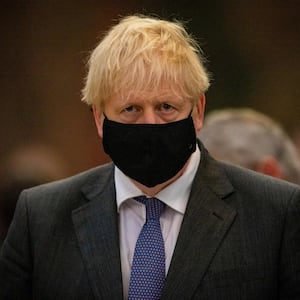Thanks in no small part to the bloviating from politicians ranging from Boris Johnson to Donald Trump, talk of herd immunity has been inescapable during the coronavirus pandemic.
Herd immunity is the theory that once a certain percentage of the population is immune to an infection, the infection can no longer find new people to claim and will effectively disappear. We also call that “exhaustion of susceptibles,” meaning that once there are no more susceptible people, the infection dies out. That’s the common way communicable diseases are controlled either naturally, or through vaccination.
President Trump has flogged the concept as part of his broader suggestion that the pandemic will resolve itself. “It’s going to disappear—I still say it,” he said this week. “You’ll develop herd—like a herd mentality.” (It’s clear what he was trying to say.)
Rather than blithely allowing millions to get infected as a solution to the pandemic, understanding how we can capitalize on the natural occurrence of immunity combined with vaccination is the best and fastest way to control the current spread of infection. While some epidemics—like Zika virus—lend themselves to herd immunity, others—like HIV infection or tuberculosis—do not.
For an epidemic to continue, each case must cause at least one additional new case in the population. When that ratio—what is called the reproduction number—is one-to-one, the epidemic stays steady, or is flat, with a constant number of new cases every day. When that ratio is more than one-to-one, the epidemic grows, and more new cases occur every day, doubling in some period.
Importantly, when that ratio is less than one-to-one, the epidemic dies out over time.
To estimate the percentage of the population that needs to become immune to achieve herd immunity, epidemiologists use the reproduction number. That figure changes over time. At the beginning of the COVID-19 epidemic, in the absence of any public health interventions and when the entire population was susceptible, the reproduction number was about 3. In that setting, the share of the population that needed to achieve herd immunity was about 67 percent. In the presence of interventions like mask wearing, distancing, and reducing contact with others, the reproduction number decreased and is currently between 1 and 2. With a reproduction number of 2, the proportion needed for herd immunity is 50 percent; at 1.5, about 33 percent.
A key part of controlling any pandemic—and perhaps achieving herd immunity—is, of course, who gets it, and how. Scientists estimate that not everyone is at the same risk for spreading this virus. Some estimate that about 10 percent of the people with SARS-CoV-2 infections cause 80 percent or more of new cases. Not only is there heterogeneity in terms of who spreads infection, but there is heterogeneity in terms of who gets infected.
Many infections in the United States have occurred in those older than 65 years, living in nursing homes, residing in jails or prisons, or working in factory or crowded workplaces. In addition, there is great heterogeneity based on race/ethnicity and socio-economic status, where persons of color and those who are low-income or live in households with more than two per room are much more likely to get infected.
Because of that, some geographic areas have experienced much greater frequencies of infection than others. For example, in Corona, Queens, New York City, 68 percent of residents tested at a clinic had antibodies to COVID-19, suggesting a large chunk of the local population was infected, whereas the overall positivity in the borough of Queens has been recently reported at 26.5 percent.
It is quite possible that, because those most susceptible to infection and those who work or live in settings where super-spreading events may occur have already been infected at high rates (over 50 percent), those groups have a form of herd immunity—and currently protect others in their social and occupational networks. In infectious disease epidemiology, we call those high-risk groups “core groups.”
It is well recognized that “core groups” have much greater susceptibility to infection and disproportionate contributions to ongoing spread due their behavior or social context. When those “core groups” are protected, reduce transmission or are immune to infection, the reproduction number for the whole population drops to below 1 and the epidemic declines. In effect, those core groups serve to protect the larger general population.
The implications of applying “core group” theory to the COVID-19 epidemic are profound. If already-infected groups in certain geographic areas reduce the likelihood of spreading infection more broadly, then the likelihood of a resurgence or “second wave” of infection in already heavily impacted areas becomes much less likely.
Dr. Anthony Fauci lambasted Sen. Rand Paul (KY) for not understanding some of these issues this past week, stating that, “If you believe that 22 percent is herd immunity, I believe you’re alone in that.”
In fact, Senator Paul may not be alone at all.
That 22 percent is an average positivity across a large population with pockets of higher and lower immunity. Those pockets of higher immunity in core groups serve as a protective barrier. Fires are much more difficult to spread when there are areas with no fuel. In fact, firebreaks do just that: they serve as cold spots to stop the progress of a wildfire.
The key to predicting whether herd immunity can be helpful is if someone can clear the infection on their own (no, for HIV) or be re-infected (yes, for tuberculosis). In the case of infections that humans cannot clear or, diseases with which they can be re-infected, herd immunity does not occur. Fortunately, for COVID-19, there is immune clearance and re-infection is extremely rare.
But given the continued susceptibility in some core groups across the United States in urban areas, lower socio-economic populations, and those working or residing in crowded settings, we can expect continued new infections in those populations. Until we have a well-deployed, effective vaccine, we must continue to practice common sense, social distancing, and mask wearing to slow the spread.



